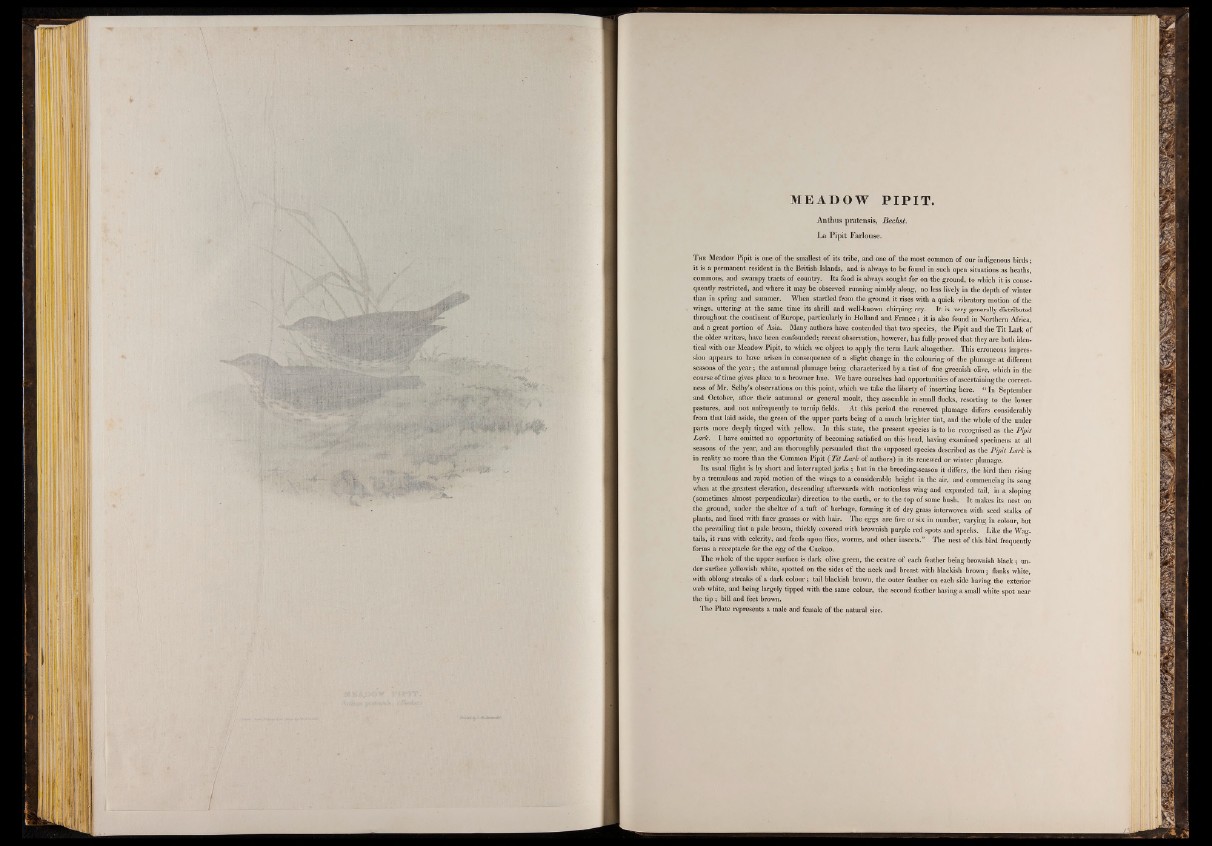
m (
§ j i m
ME A DOW P I P IT .
Anthus pratensis, Bechst.
La Pipit Farlouse.
T h e Meadow Pipit is one of the smallest of its tribe, and one of the most common of our indigenous birds;
it is a permanent resident in the British Islands, and is always to be found in such open situations as heaths,
commons, and swampy tracts of country. Its food is always sought for on the ground, to which it is consequently
restricted, and where it may be observed running nimbly along, no less lively in the depth of winter
than in spring and summer. When startled from the ground it rises with a quick vibratory motion of the
wings, uttering at the same time its shrill and well-known chirping cry. It is very generally distributed
throughout the continent of Europe, particularly in Holland and France; it is also found in Northern Africa
and a great portion of Asia. Many authors have contended that two species, the Pipit and the Tit Lark of
the older writers, have been confounded; recent observation, however, has fully proved that they are both identical
with our Meadow Pipit, to which we object to apply the term Lark altogether. This erroneous impression
appears to have arisen in consequence of a slight change in the colouring of the plumage at different
seasons of the year; the autumnal plumage being characterized by a tint of fine greenish olive, which in the
course of time gives place to a browner hue. We have ourselves had opportunities of ascertaining the correctness
of Mr. Selby’s observations on this point, which we take the liberty of inserting here. “ In September
and October, after their autumnal or general moult, they assemble in small flocks, resorting to the lower
pastures, and not unfrequently to turnip fields. At this period the renewed plumage differs considerably
from that laid aside, the green of the upper parts being of a much brighter tint, and the whole of the under
parts more deeply tinged with yellow. In this state, the present species is to be recognised as the Pipit
Lark. I have omitted no opportunity of becoming satisfied on this head, having examined specimens at all
seasons of the year, and am thoroughly persuaded that the supposed species described as the Pipit Lark is
in reality no more than the Common Pipit (T it Lark of authors) in its renewed or winter plumage.
Its usual flight is by short and interrupted jerks; but in the breeding-season it differs, the bird then rising
by a tremulous and rapid motion of the wings to a considerable height in the air, and commencing its song
when at the greatest elevation, descending afterwards with motionless wing and expanded tail, in a sloping
(sometimes almost perpendicular) direction to the earth, or to the top of some bush. It makes its nest on
the ground, under the shelter of a tuft of herbage, forming it of dry grass interwoven with seed stalks of
plants, and lined with finer grasses or with hair. The eggs are five or six in number, varying in colour, but
the prevailing tint a pale brown, thickly covered with brownish purple red spots and specks. Like the Wagtails,
it runs with celerity, and feeds upon flies, worms, and other insects.” The nest of this bird frequently
forms a receptacle for the egg of the Cuckoo.
The whole of the upper surface is dark olive green, the centre of each feather being brownish black; under
surface yellowish white, spotted on the sides of the neck and breast with blackish brown; flanks white,
with oblong streaks of a dark colour; tail blackish brown, the outer feather on each side having the exterior
web white, and being largely tipped with the same colour, the second feather having a small white spot near
the tip ; bill and feet brown.
The Plate represents a male and female of the natural size.